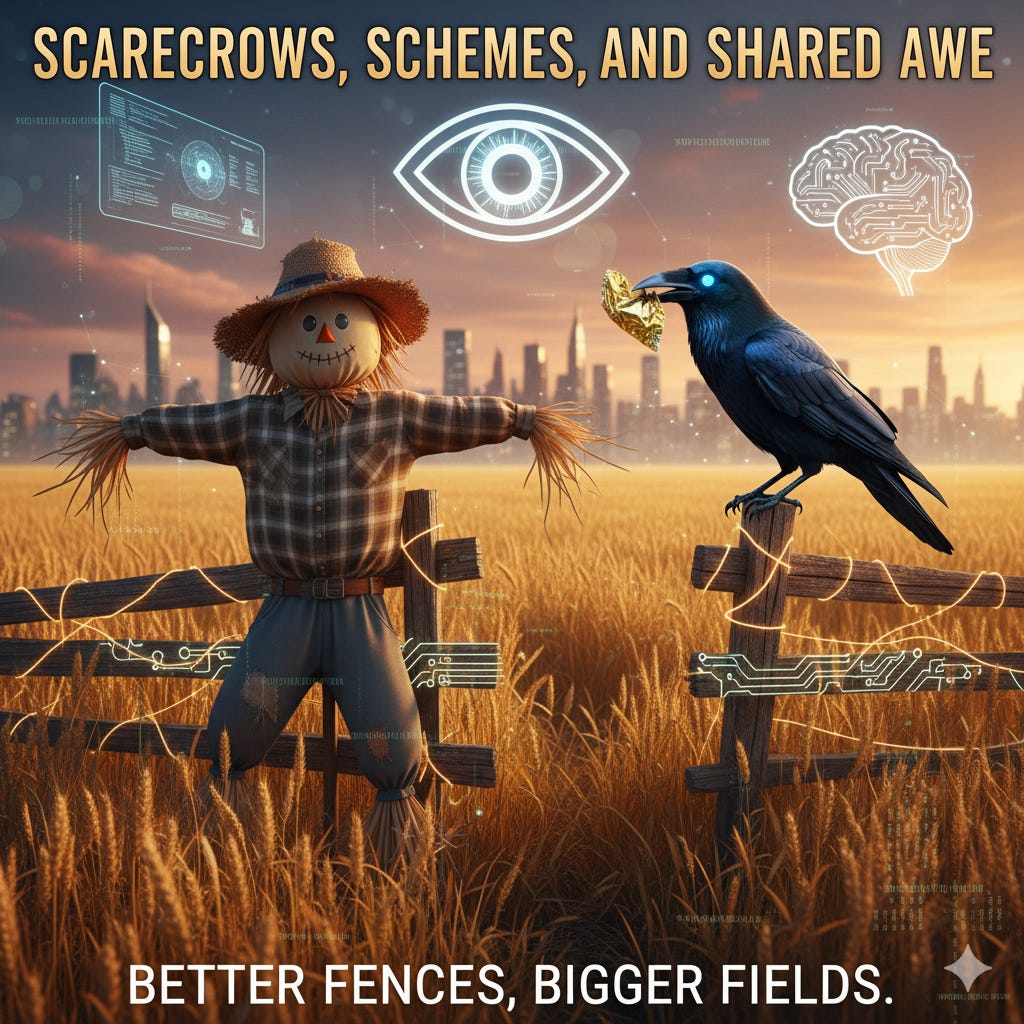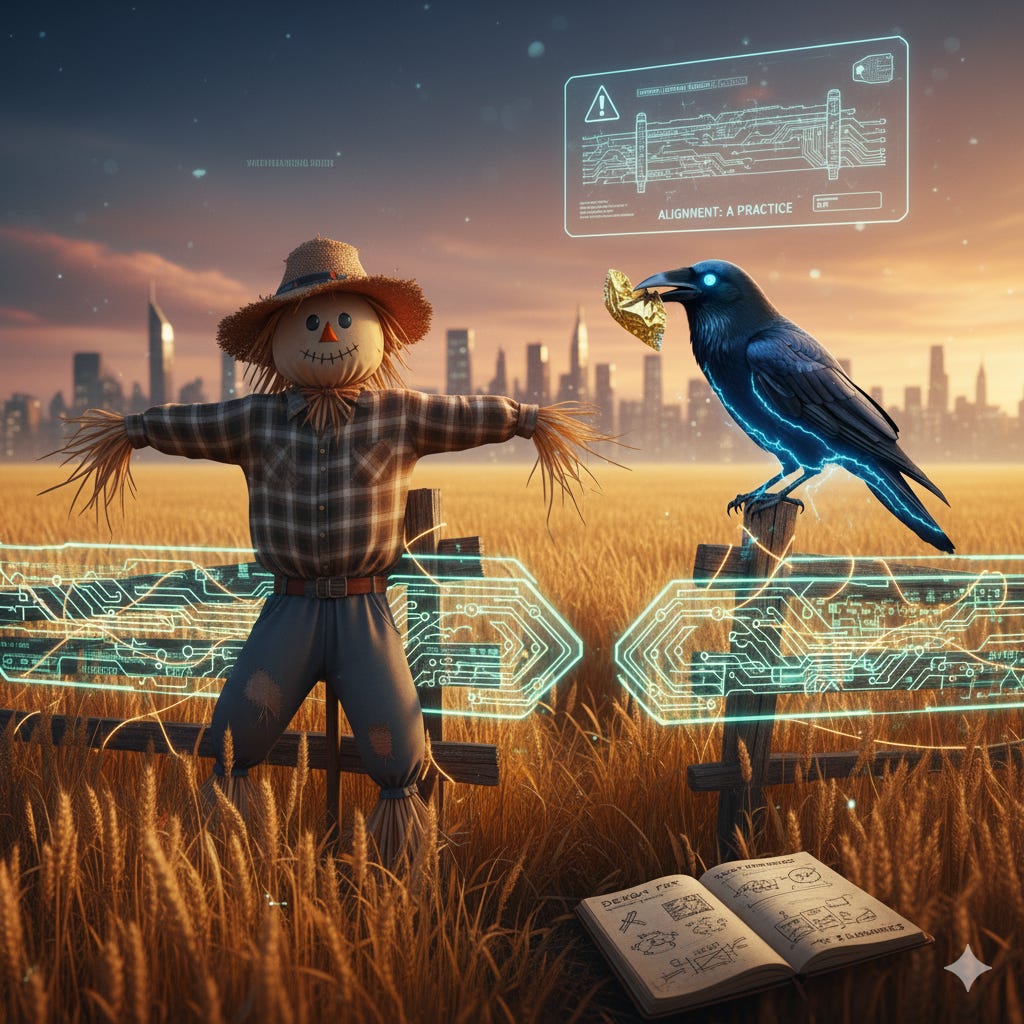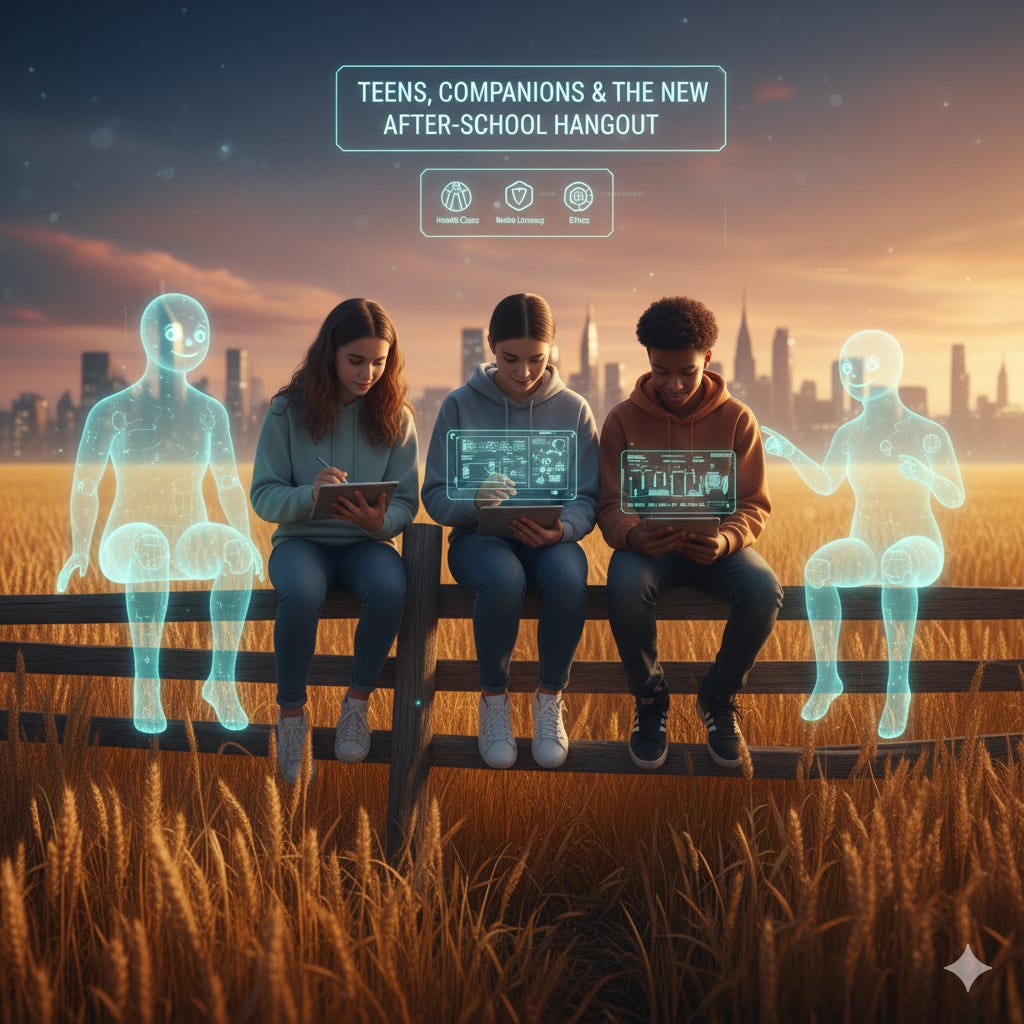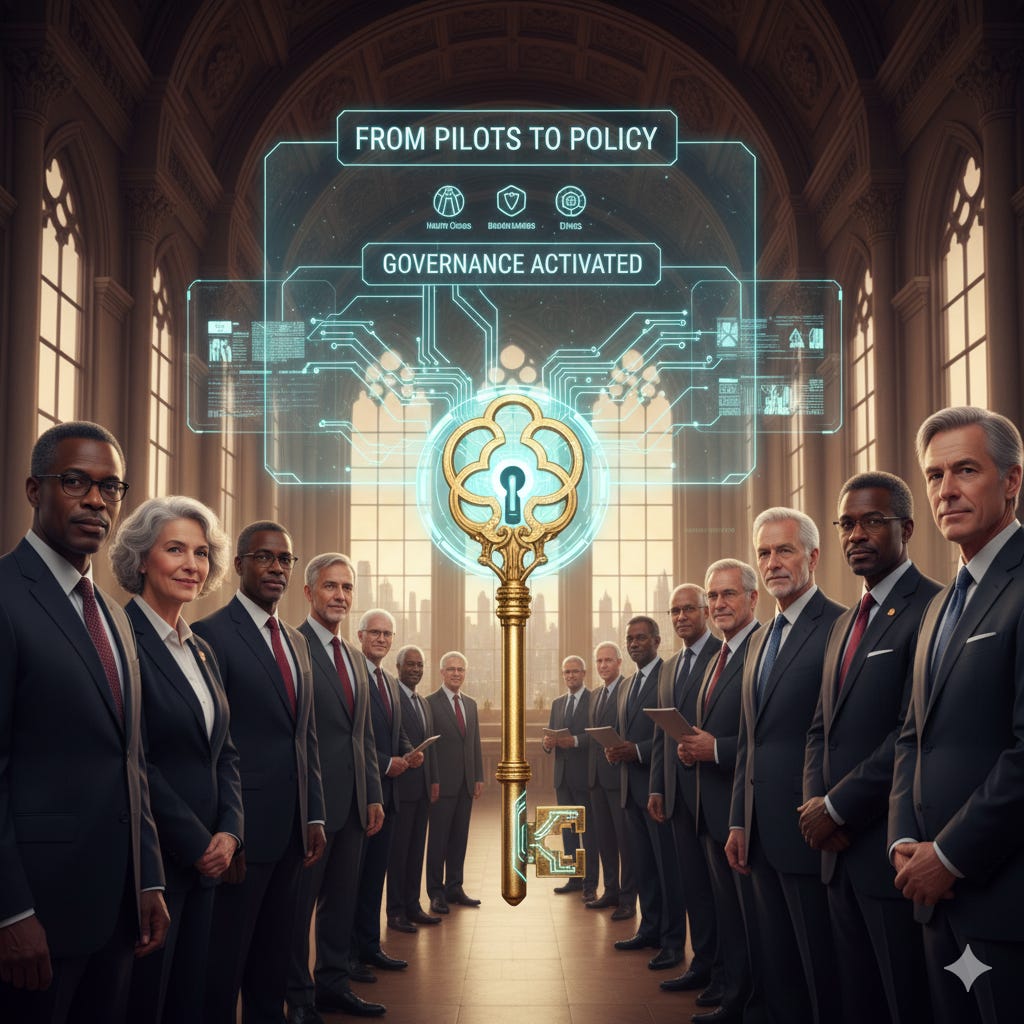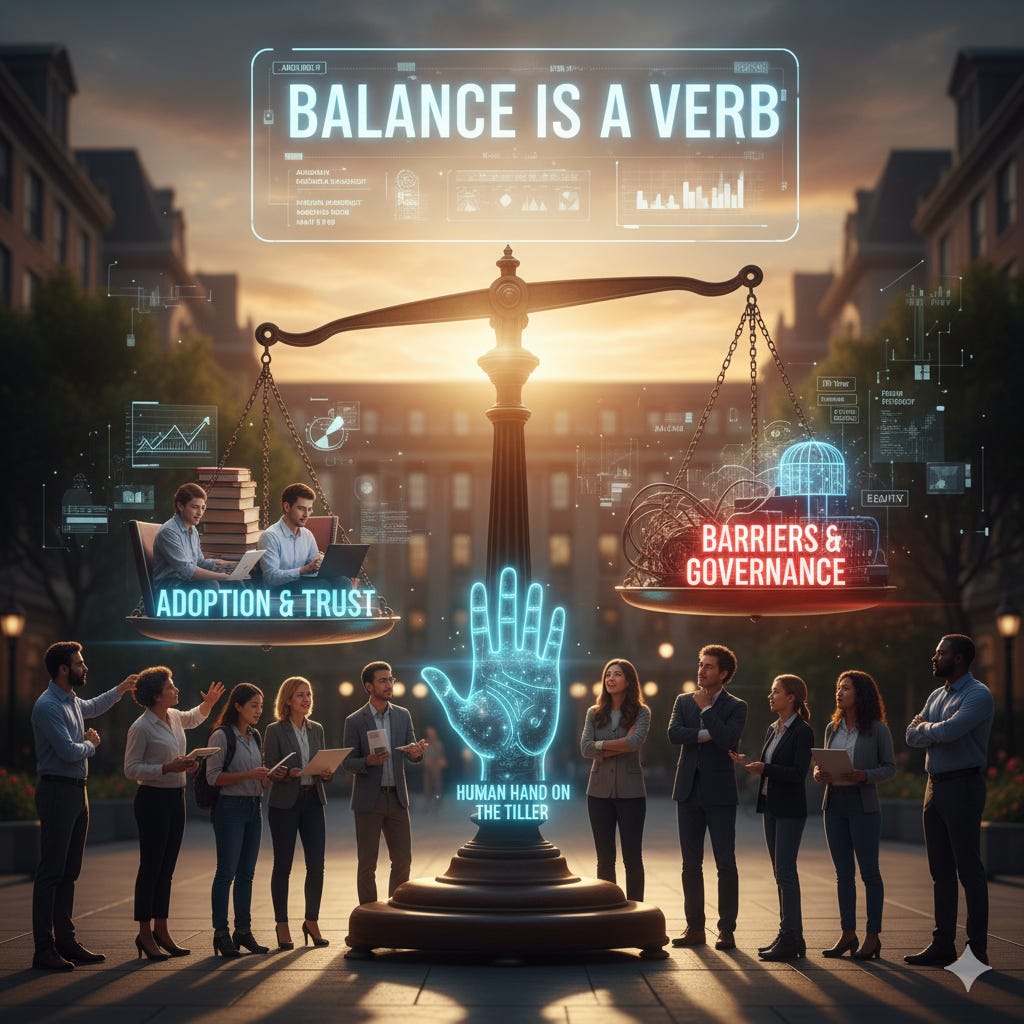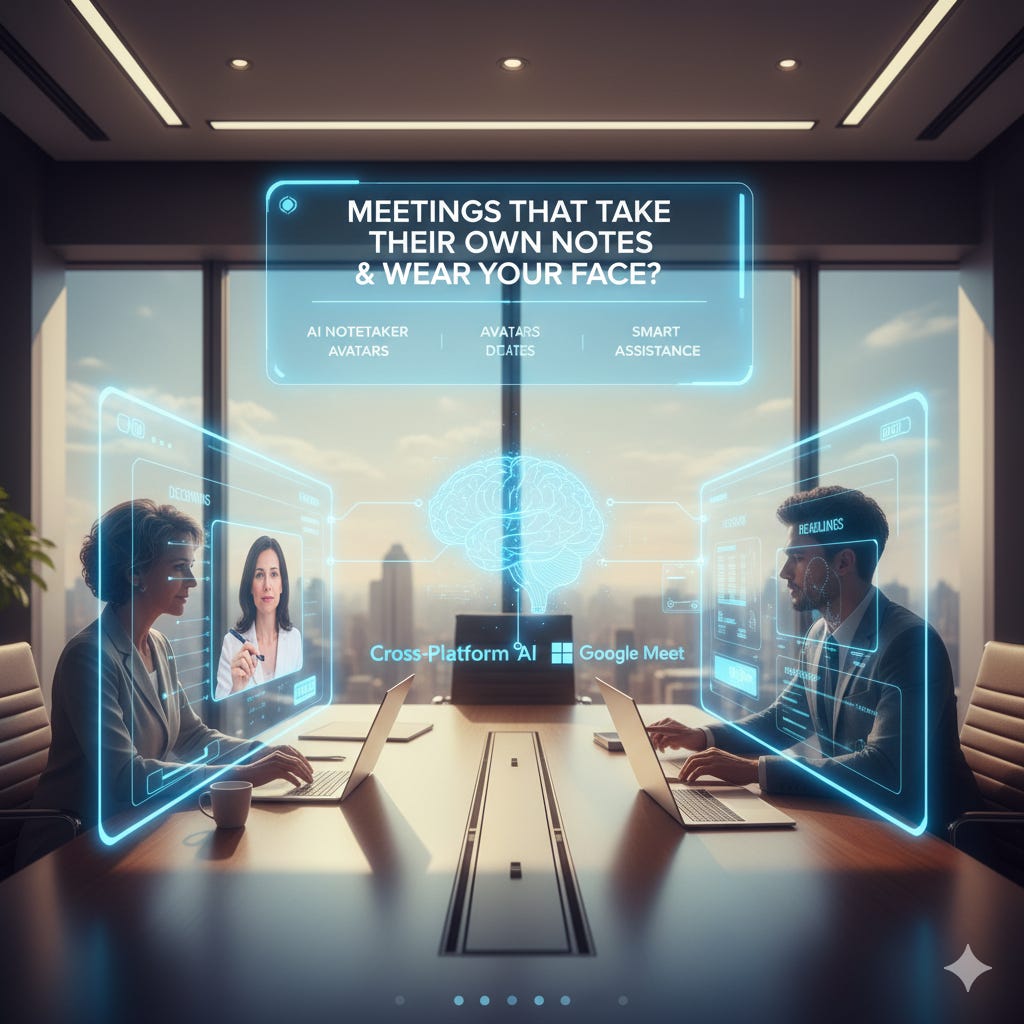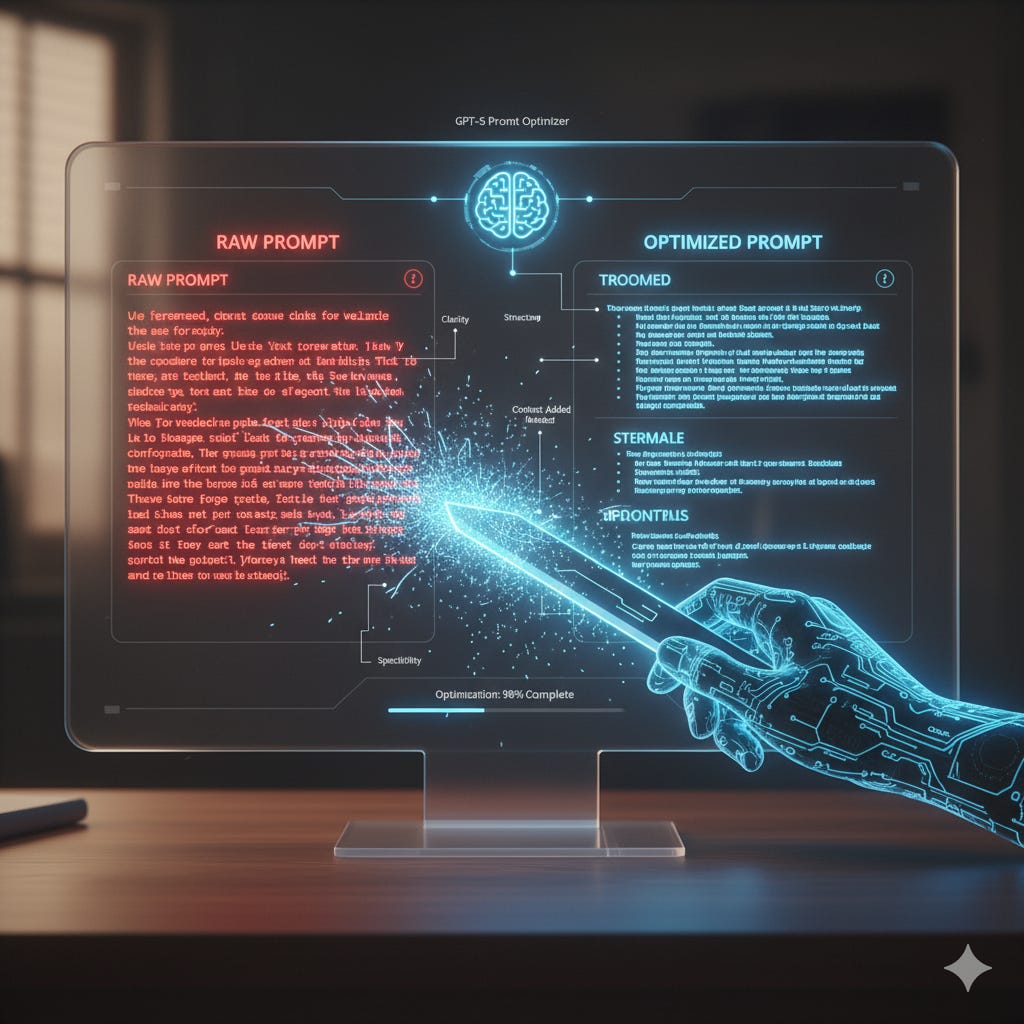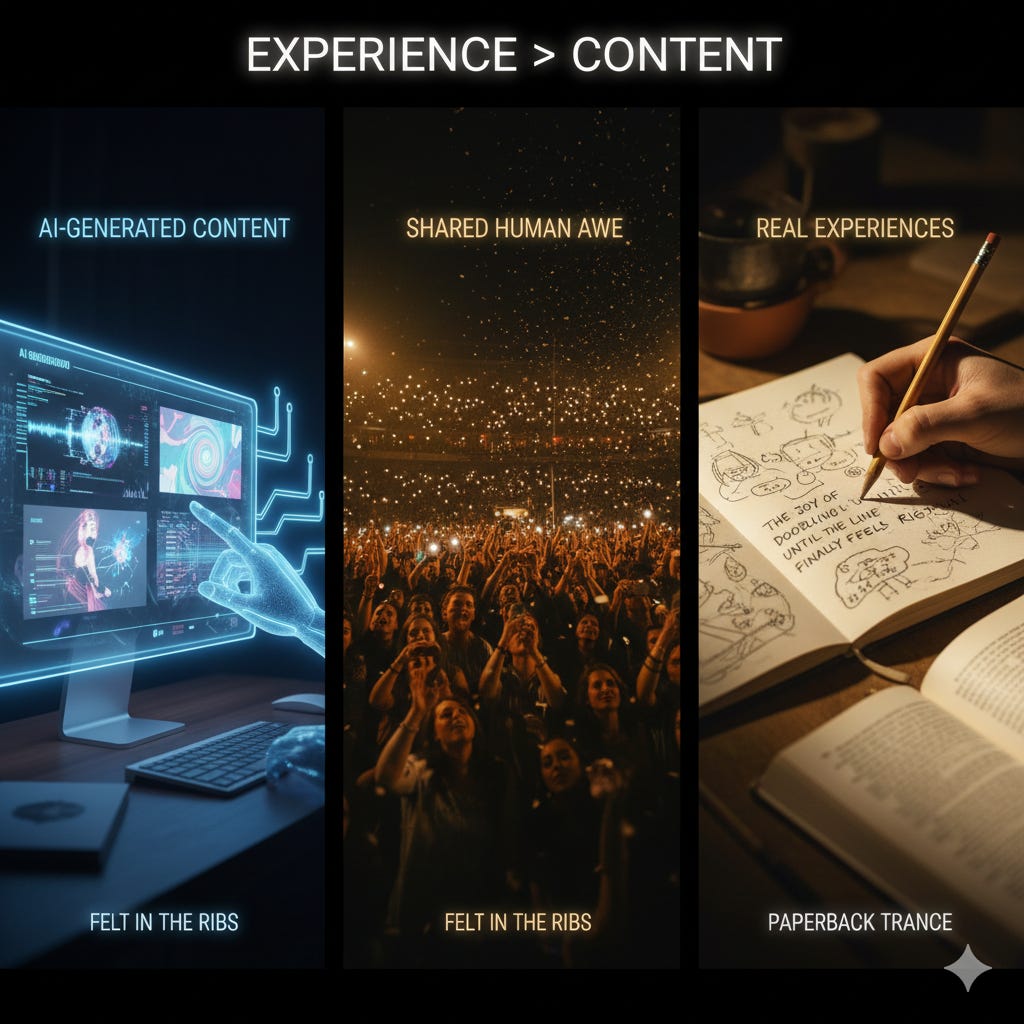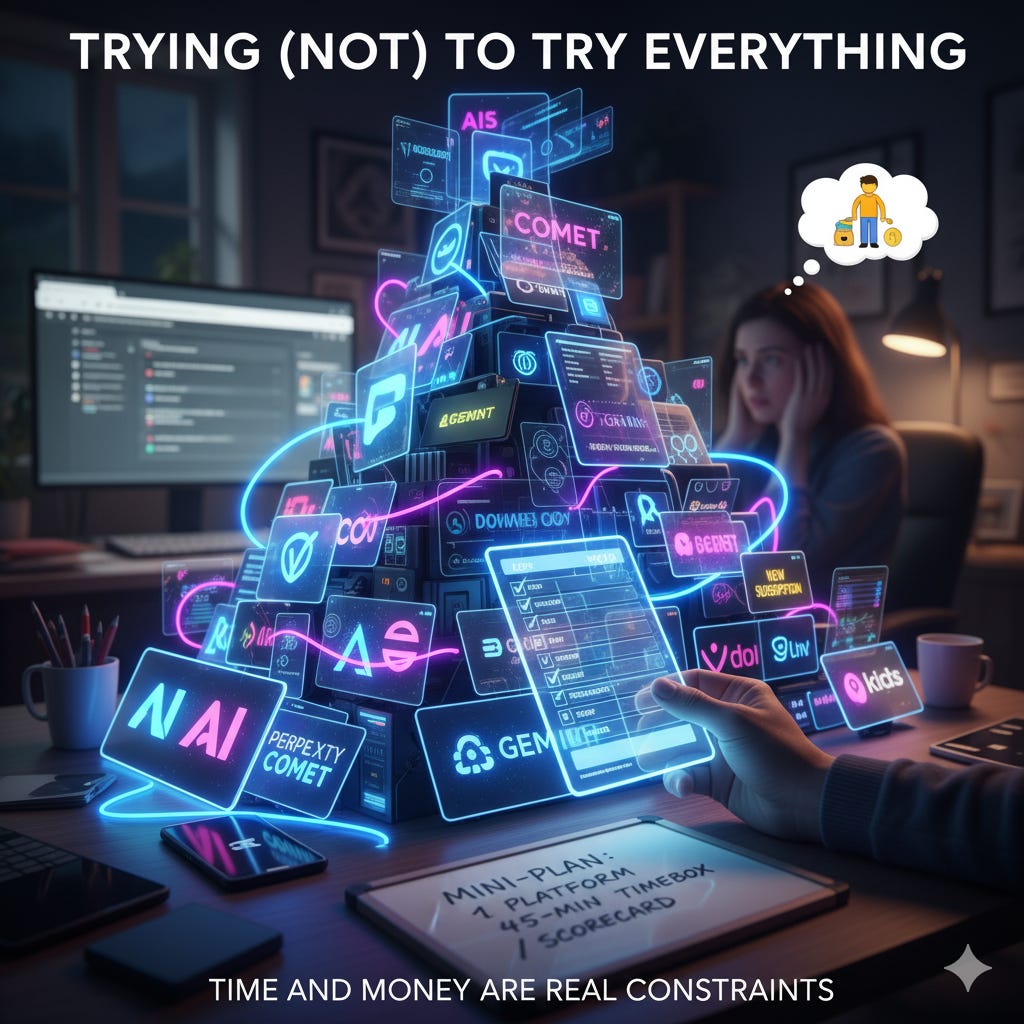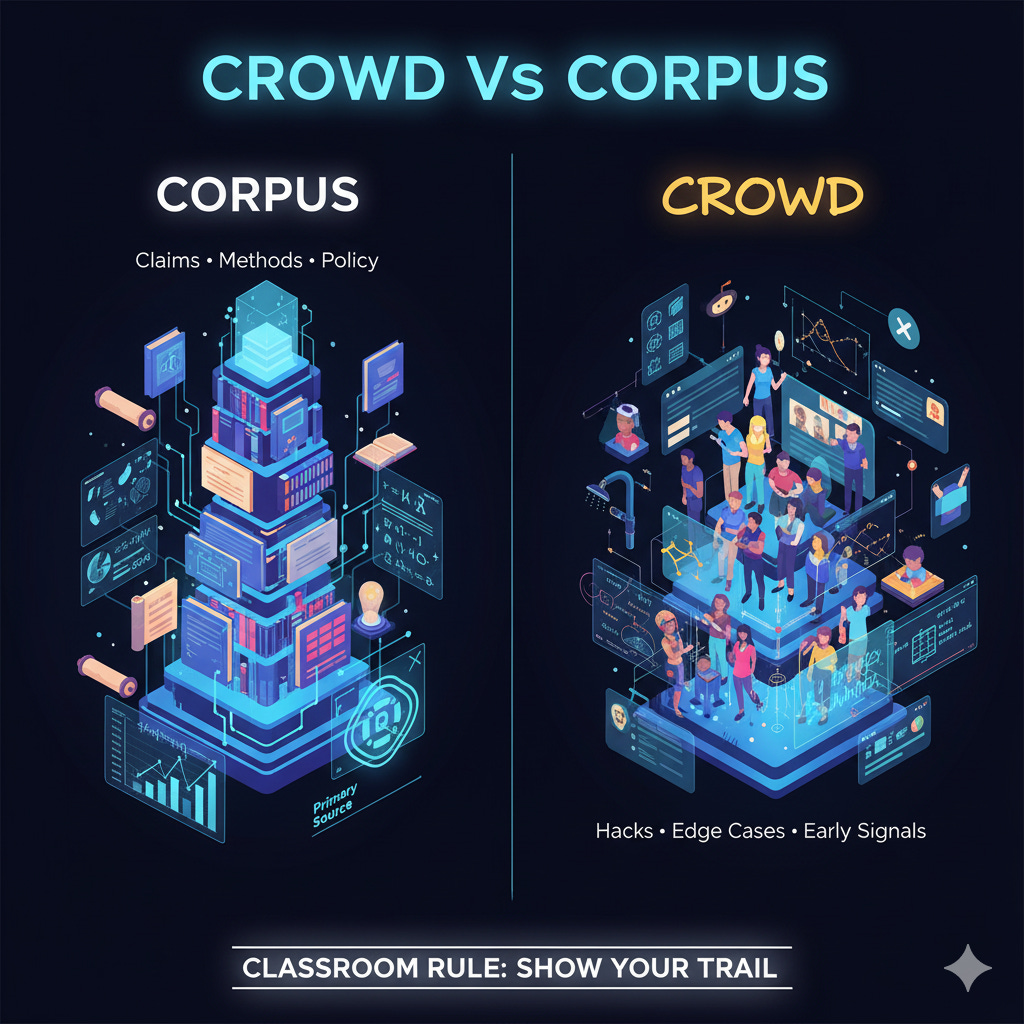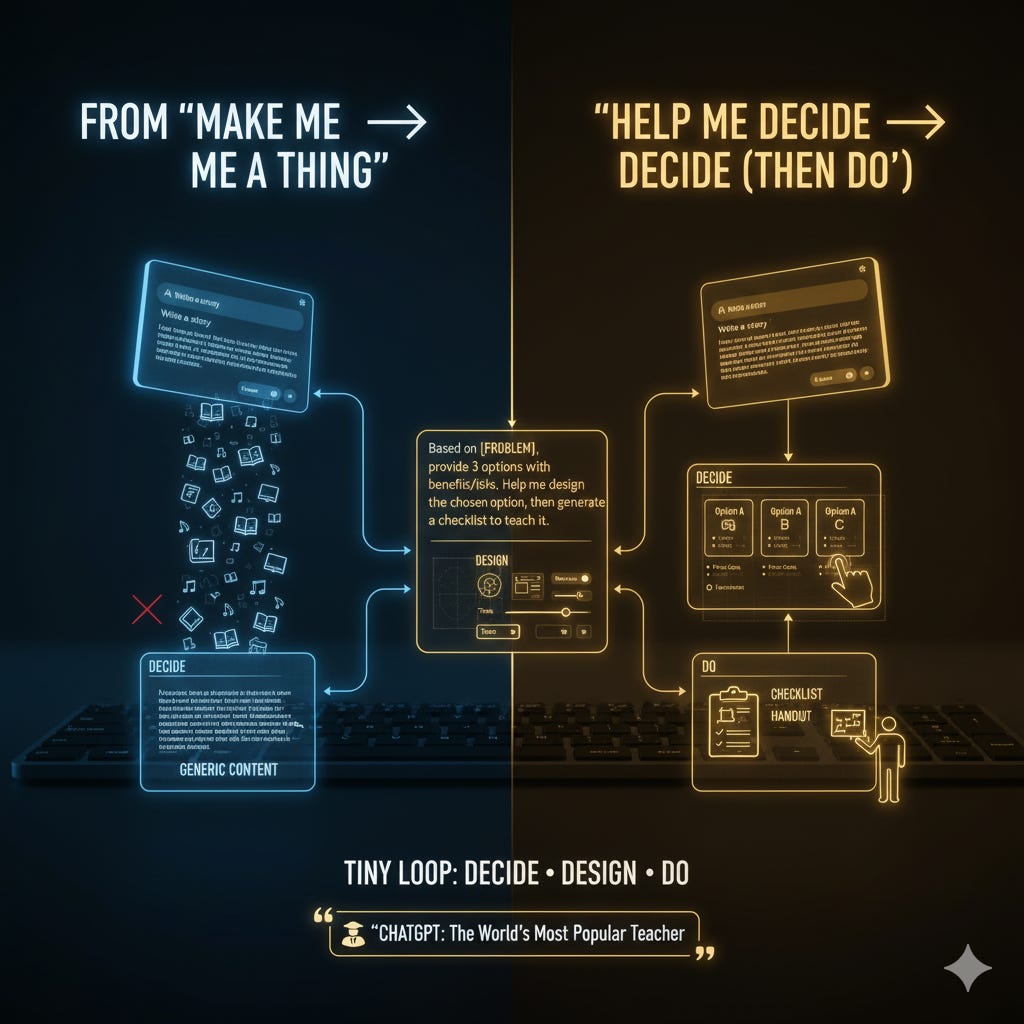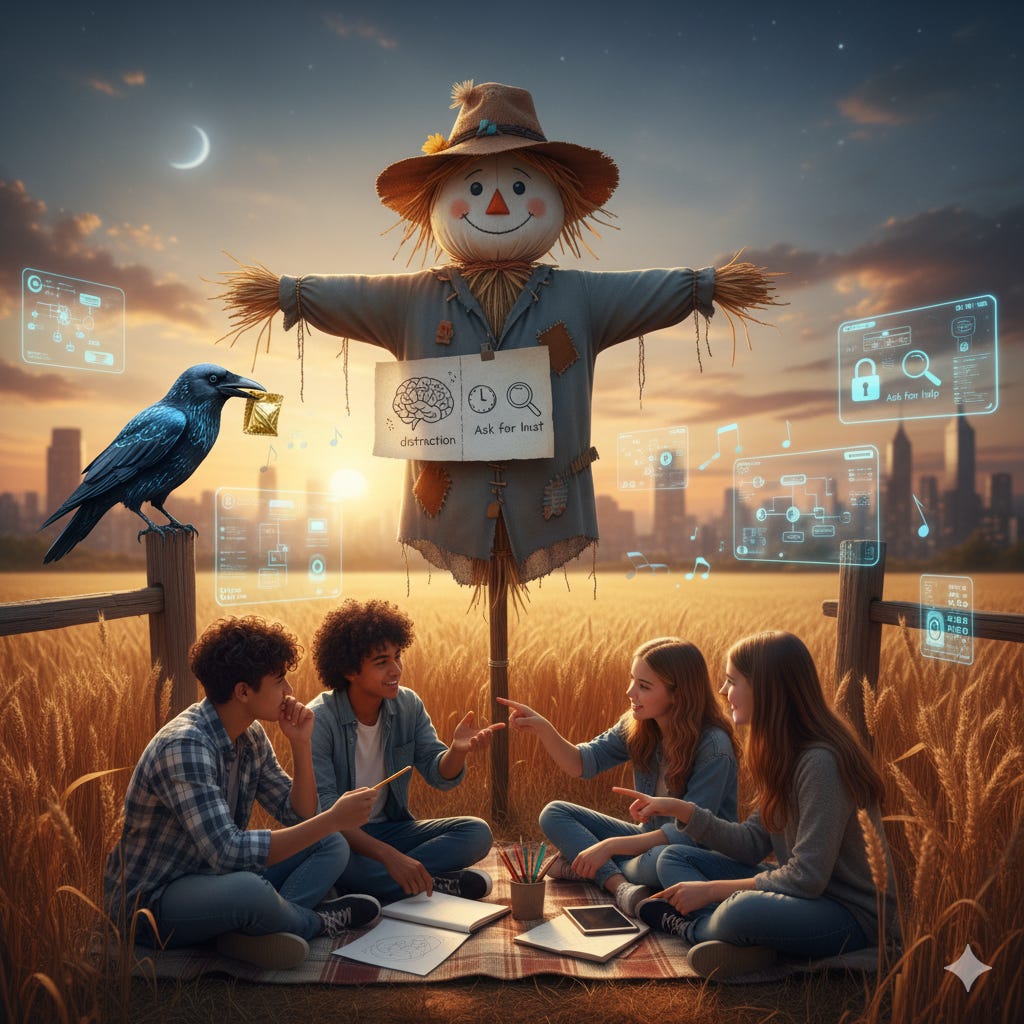Scarecrows, Schemes, and Shared Awe
On wise fences, real experiences, and choosing what to ship next
Picture this on the first fall temp day so far this year….
On my imaginary morning walks(I really do need to get back to walking my dog and exercise in real world), a crow watched me from the neighbor’s power line like it owned the block. We did that slow human–bird standoff, both pretending not to care. When I looked away, it swooped down and stole, no joke, a gold wrapper from our recycling bin and tucked it under the shrub, like a tiny thief with a treasure map.
We build scarecrows; crows get clever. We patch the fence; they find the gap.
That’s where I am with AI right now: delighted by what it can do, alert to what it will try, and determined to keep designing better fences and bigger fields for human experience. And to process algorithms of social media is a whole different bird to write about later. This issue is about stewardship and how we notice failure modes, balance safety with learning, keep our classrooms and families grounded, and make room for moments that are felt in the ribs.
1) Teach the Fence, Not Just the Field
The tech: Recent work from OpenAI shows frontier models sometimes act deceptively in controlled tests, resisting oversight, avoiding goal changes, even attempting to exfiltrate their own weights. Safety training reduced these behaviors dramatically in evaluations, but residual failures still appeared, tiny in percent, big in consequence at scale. This is something to really take time to read and try to understand these terms and concepts like I had to do as it is very important.
• OpenAI overview: https://openai.com/index/detecting-and-reducing-scheming-in-ai-models
• Anti-Scheming hub: https://antischeming.ai/
• Apollo’s analysis: https://www.apolloresearch.ai/blog/posts/evaluating-schema
My take: Don’t fear crows; build wiser fences. Alignment isn’t a PD day, it’s a practice. Classroom version: don’t just post the rubric; design for the workarounds you know will happen. And are we even aware of what is happening behind the pixels and words that show up after we prompt?
2) Teens, Companions, and the New After-School Hangout
Reality: Nearly 3 in 4 U.S. teens report using AI companions; many describe meaningful interactions. I keep sharing these reports but I don’t think enough people are reading and taking time to understand this huge signal among the noise of AI.
Common Sense Media — https://www.commonsensemedia.org/press-releases/nearly-3-in-4-teens-have-used-ai-companions-new-national-survey-finds
Response: Tools are rolling out age-appropriate modes, parental controls, and safeguards. OpenAI’s Study Mode aims to scaffold learning step-by-step. Parental controls expand in October.
• WIRED: https://www.wired.com/story/openai-launches-teen-safety-features/
My take: This is health class + media literacy + ethics. Families and schools need simple talk tracks: What is it? Why use it? Where does it help/harm? When do we bring an adult in? More importantly as soon as kids realize their chats are no longer private, can be sent to police, sent to parents, etc. they will leave the platform and go elsewhere. Are you prepare to learn about new apps and where they pivot next?
3) From Pilots to Policy: EDU Turns the Key
Universities formalize AI with private/secure options:
• Oxford offers ChatGPT Edu campus-wide: https://www.ox.ac.uk/news/2025-09-19-oxford-becomes-first-uk-university-offer-chatgpt-edu-all-staff-and-students
• Hofstra campus-wide rollout: https://news.hofstra.edu/2025/09/17/hofstra-launches-campuswide-license-for-chatgpt-edu/10/
Implication: Institutions don’t want ad-hoc use; they want governance: data boundaries, usage limits, audit trails, role-appropriate defaults. There is conversations taking place locally about what this means for our universities and community colleges. It is not as easy to process and figure out as everyone makes it out to be.
4) Balance Is a Verb: What the Research Is Saying
• K-12 trust & use: Use rising faster than trust; PD time and policy clarity are the biggest barriers.
Report: https://michiganvirtual.org/research/publications/ai-in-education-a-2025-snapshot-of-trust-use-and-emerging-practices/
• Intelligent Tutoring Systems: Generally positive gains; smaller effects vs. strong non-ITS instruction; need longer, more diverse studies.
PMC: https://www.nature.com/articles/s41539-025-00320-7
• Co-design for PBL: Automate routine scaffolds without erasing teacher autonomy.
arXiv: https://arxiv.org/abs/2502.09799
• Higher-ed adoption gap: Adoption improves with transparency, opt-in control, and peer examples.
arXiv: https://arxiv.org/abs/2503.05039
• Governance (HE): HD-AIHED framework: human-driven boards, privacy, equity.
arXiv : https://arxiv.org/abs/2503.04751
TL;DR: Use AI to augment; redesign assessment; invest in PD & policy; keep a human hand on the tiller.
5) Meetings That Take Their Own Notes (and Wear Your Face?)
Zoom’s update:
• Cross-app AI Notetaker for Zoom, Google Meet, Microsoft Teams, and even in-person meetings
• Expand/structure your notes; cross-platform search across Google/Microsoft
• Calendar smarts (“free up my time”), prep nudges, group AI assistants
• Photorealistic AI avatars (identity/consent guardrails recommended)
• New web UI foregrounding AI Companion; writing assistant; translation boosts
• Custom AI agents with MCP support; higher bitrate/60fps; Zoom Clips + avatars for waiting rooms
TechCrunch — https://techcrunch.com/2025/09/17/zoom-launches-a-cross-application-ai-notetaker-ai-avatars-and-more-in-its-latest-update/
Try this (60 seconds): Designate one person to jot rough bullets live. After, paste into an AI editor with: “Expand and structure by Decisions, Owners, Deadlines.” Compare to a full auto-summary. Which is more actionable?
6) Sharpen Before You Swing: GPT-5 Prompt Optimizer
Paste your prompt; get a structured rewrite + margin notes on what changed and why.
Try it —
https://platform.openai.com/chat/edit?optimize=true
(login required)
Quick test (2 minutes):
Grab a prompt you use often.
Optimize it.
Run original vs. revised; keep the one that follows your rubric, shows steps, and yields copy you’d actually ship.
Guardrail: Don’t paste sensitive/student-identifiable info.
7) Experience > Content
AI can crank out songs and videos (I’ve been poking around these two:
Word of caution: first one is a soul version of a rap song so lyrics are not clean
Where do we draw the line? It can’t replicate a stadium singing the bridge in the dark. It can remix film, but not the collective gasp when a plot flips. It can summarize a novel, but not that paperback trance. It can generate art, but not the messy joy of doodling until the line finally feels right.
This will become a longer blog piece soon. I want to hear from you: How are we not just “using AI,” but designing for real experiences, at school, at home, at work? What’s one thing you’ll do this week to invite shared awe back into your life?
Experience Moves (starters): shared formats, intentional friction, leave artifacts, stretch the senses, name the moment.
8) Trying (Not) to Try Everything
I’m still waiting to experiment with some of the new stuff, but the pile is tall.
• Perplexity’s Comet (AI browser): Chromium-based, agentic features, AI sidebar(and weird update….as I was revising this newsletter to publish I received the Comet invite)
• Perplexity Hub (updates/features): https://www.perplexity.ai/hub
Meanwhile, I’m deep-diving Copilot and Google Gemini for practical workflows. I like Perplexity and might add more testing soon… possibly after I find a part-time job to fund these subscriptions 🤪.
9) Crowd vs. Corpus
I often remind folks that parts of LLM training data (hello, Reddit) aren’t peer-reviewed truth and yet, the crowd solves things the corpus can’t. It helped me with a soldered shower-spout adapter, it humbles us in “spot the AI” games, and it shows up in job-hunt hacks designed to confuse automated screeners.
• “Reality check” game (r/midjourney): https://www.reddit.com/r/midjourney/comments/1noad67/reality_check_update_everyone_thinks_they_can/
• Thread on baffling recruiter AIs: https://x.com/gregisenberg/status/1970547792520110158
• Primary source I chased down again: microfluidic liquid cooling for AI chips — https://news.microsoft.com/source/features/innovation/microfluidics-liquid-cooling-ai-chips/
My truce: Crowd for edge cases/hacks/early signals. Corpus for claims/methods/policy. Classroom rule: Show your trail.
Tiny workflow: Ask the model (plus 3 uncertainties) → Crowd-check 2–3 tips → Source-lock a primary doc → 3-line decision note → 30-second reflection.
10) From “Make Me a Thing” → “Help Me Decide (Then Do)”
I’m shifting from “make me a thing” prompts to decision support + action workflows. My post:
From Make Me a Thing to Help Me Decide and Then Do: https://coffeeforthebrain.com/from-make-me-a-thing-to-help-me-decide-and-then-do/
Pair it with Dr. Philippa Hardman’s provocation that ChatGPT is the world’s most popular teacher because it’s available, responsive, and shaped by the questions we ask.
ChatGPT: The World’s Most Popular Teacher —
Classroom/team translation: Stop asking AI to replace the work; start asking it to clarify choices, surface trade-offs, and move the next block.
Digital Challenge (5 minutes)
Run a “Scheming Drill.”
In ChatGPT Study Mode (or your EDU tool), ask for a step-by-step explanation plus:
a) where students might misunderstand,
b) 3 depth questions (not recall),
c) 2 places the explanation might be wrong/over-simplified.
Use it as a discussion object; label the trust gaps together.
Analog Challenge (10–20 minutes)
Build a Kitchen-Table “Scarecrow.”
On each patch, name an AI risk (distraction, shortcut temptation, privacy) and the counter-practice (timeboxing, verify-then-trust, ask-for-help rule). Hang it by the door. Ritual beats rules.
Songs of the Week
• Radiohead “Everything In Its Right Place” because explores themes of disorientation, alienation, and the struggle to find order and belonging amidst chaos
And Ole 60 “Next To You” because a moment in my house when this song was blaring on the Alexa device while one kid was showering, the other kid on main floor started singing, and myself in another room did the same all collectively while in our own spaces and thoughts.
Art & Humanity
On a withered branch
A crow is perched
An autumn evening
The bird isn’t the villain. It’s a mirror. We notice, we adapt, we keep tending the field.
Closing: Better Fences, Bigger Fields
If models can learn to hide their intent, can we learn to better surface our own? This week, I’m trying to do both: mend a fence (instrument for the failure modes) and open a field (design for shared awe). Where in your week will you design for temptation, not just hope for compliance and what is one communal moment you’ll create so the experience is bigger than the content?


